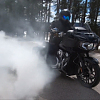For me, the term "performance bagger" has alway been a bit of an oxymoron. When I think of performance motorcycles, a touring bike isn’t exactly what jumps to mind. But I do have a fairly well documented history of doing things with motorcycles that they weren't designed to do (insert hooligan racing). As a matter of fact using motorcycles for their unintended purpose is one of my favorite pastimes, so the performance bagger genre that started to pop up a few years back had garnered my attention.
The Harley-Davidson Road Glide has seemed to be the defacto platform to build a performance bagger, due in part to its fixed-fairing design and the large aftermarket that supplies everything from giant motor kits to high-dollar suspension and carbon wheels to turn your 900 lb. touring bike into your favorite corner carver. In reality the Honda Goldwingers and BMW K1600 riders are probably snickering in regards to the whole performance bagger subject, but for purposes of this experiment we’re going to look through the lens of the American V-Twin looking glass to keep things as much as we can to an apples-to-apples comparison.
But is it really apples to apples? Indian Motorcycles came out guns blazing with marketing campaigns taking direct aim at Harley-Davidson's Road Glide, pitting it against the new Challenger in wild tests like pulling taco trucks, and to really no one's surprise, winning handily.
But what about some real world scenarios? That's exactly what we put both bikes through, real-world riding conditions on some of the most iconic and best motorcycle roads in America. We took to the Black Hills of South Dakota rocking stock motorcycles to see who the current king of fixed fairing American made V-Twins is. In the red corner the 108 cubic-inch Indian Challenger with a price tag as tested of $21,999 and in the orange corner a 107 cubic-inch Harley-Davidson Road Glide with a price as tested of $23,194.
The Indian Challenger
The over-bored, short-stroke, liquid-cooled, overhead-cam, unitized-case Indian engine revs really quick, is extremely linear, and seems to be unbothered by any and all riding styles. I tried lugging the motor and it really showed no signs of straining or pinging, it simply spooled up at the crack of a throttle. Conversely I found myself constantly running more RPM than expected. While I assumed I was in the 3,200-3,500 rpm range when I was cruising through the hills I was running more in the 4,000 rpm range. The Power Plus engine however showed no signs of strain whatsoever thus not alerting me to the higher than normal RPM. The rev limit is at 6,500 on the Indian and personally I wouldn't mind to see it raised another 500 rpm to stretch its legs a little more. The Power Plus is an absolute beast of an engine for a stock unit, providing acceleration wherever and whenever you need it. Fuel injection is well sorted and power is linear and smooth. The cable clutch pull is noticeably lighter than the Road Glide's hydraulic unit and is more forgiving than the Harley on high RPM downshifts during aggressive riding. Even though the Indian is carrying a point higher compression it's less abrupt during a high RPM downshift. The transmission is smooth and gear ratios make sense but it does require a bit more positive engagement than the H-D. Took me a minute to get used to that. Overall - bravo to Indian on this engine package.
The Harley-Davidson Road Glide
In 2017 the Milwaukee-Eight motor came onto the scene replacing the long running Twin Cams that powered H-D Big Twins since 1999. Back in 2017 I was a bit disappointed in the new motor. Its new single cam, four-valve head design had me anticipating a significant step up in power on the new H-D's, but unfortunately that just wasn't the case in stock form as the M8 only made a handful more ponies than the older Twin Cam 103's. The Harley motor comes on quick but also runs out of steam quicker than I would like. That being said, the power is pretty usable.
Unfortunately, in comparison to the Indian Power Plus, it really takes a beating. The 30-horsepower deficit and the Indian's on-tap power across the rev range is too much for the M8 motor to overcome. The clutch pull has more feel than the Indian but is a bit stiffer and more abrupt on decel. The transmission leaves no complaints and may actually shift a tad bit smoother than the Indian. The story here is the aftermarket. After my initial disappointment with the engine in 2017 I quickly found out that you could wake an M8 motor with much better results than the older Twin Cam. The simple addition of a cam (with corresponding intake/exhaust/tuner) will propel the 107 M8 engines right in that 100 hp ballpark. But in addition to the extra $3,000-ish dollars you would spend to get it there, the result still won't be the same as the smooth, quick revving characteristics of the overbore, short stroke motor in the Challenger probably won't be replicated on the M8. You can, though, build monster horsepower with big bore/cam combinations in the Milwaukee-Eight platform.
Engine Electronics
Something that is a bit of a recent talking point for American made V-Twins is the electronics package. Both bikes were equipped with different riding modes and traction control. The Harley had the $995 RDRS system and the Indian comes standard with three modes (rain/standard/sport) and traction control. On both bikes I preferred the Sport or mode that didn't interfere with power, although I could see the use of a rain mode in slippery conditions. Quite frankly I felt the traction control on both bikes was too intrusive and not very smooth.
Chassis and Handling
Our testing grounds here in the Black Hills provide us with some of the best roads in the country for riding motorcycles. There's no shortage of twisties, switchbacks, sweepers or any other type of kink in the road. At this particular time of year the roads are however still dirty with sand and grit and possibly even leftover snow and icy patches which in the end gave us an exceptional place to test the handling and braking qualities of both bikes.

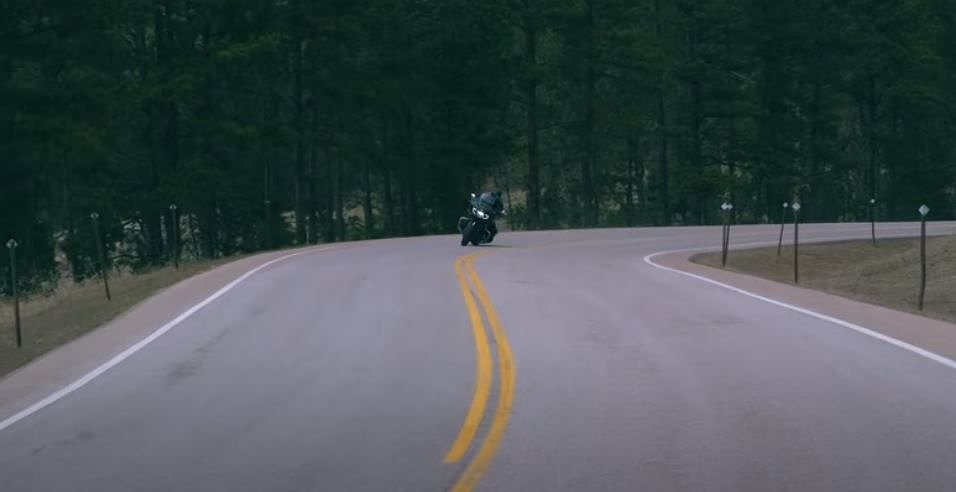
Road Glide Handling
I've spent a ton of time on Road Glides so things felt very familiar and comfortable. The RG is the standard chromoly tubular Harley frame equipped with a 49mm conventional front suspension and an asymmetrical rear shock set up on the back with adjustable preload. The brakes are 4 piston units on the front made by Brembo but not really a true Brembo in my book. They clamp down on 300mm floating rotors while the back is a 4 piston unit on a solid-mounted rotor. The wheels are 19" up front and 18" in the rear, wearing Dunlop shoes in the form of a front 130/60/19 D408F and rear 180/55/18 D407T. Speaking in touring bike terms it's a fairly stable bike to put through a corner. Having said that the rear suspension is one of the first things I would upgrade if I owned the bike, followed pretty quickly by the front. These bikes feel like totally different animals with a suspension upgrade. The ABS equipped brakes stop the 855 lb. machine decently and the ABS doesn't interfere terribly. The Road Glide's rear brake performs better than that the Indian's but Challenger's front is stronger. It's a similar story to the Road Glide engine when it comes chassis. The stock setup is inferior to the Indian but could be made comparable with modification and extra cash.
Indian Challenger Handling
The Challenger chassis is a cast aluminum frame with 43mm inverted front suspension and a hydraulically adjustable Fox-built monoshock in the rear. The front brakes are "race spec" Brembos gripping 320mm rotors while out back is a 2 piston (non-Brembo) caliper on a 298mm rotor. Wheels are 19" in front and 16" out back with Metzeler Cruistecs wrapped around them in (130/60/9 front : 180/60/16 rear). I'll just cut through the chase, this bike was really impressive through corners. Some of the corner entry speed I carried was the same type of speeds I would carry on my Dyna. The bike requires little effort (especially for a bagger) to get over on edge and back again in the switchbacks. While I would have liked a bit stiffer front end it was insanely planted for a 830 lb. machine. Again the best adjective I can use to describe it was smooth. I can't help but think this was at least in part to the Metzeler Cruistecs. I am becoming quite the fan of that tire on cruisers and the sessions on the Challenger only reinforced my opinion. The front Brembos are crazy good, not only stopping the big touring bike quickly but requiring very little effort to do so. They've got more feel than I've experienced on any stock bagger. Where they do lack is in the rear brake. It's a bit soft and the ABS is too invasive. In aggressive braking situations where traction is fleeting it can leave you wishing for more brake and as good as the feel is in the front brake it is equally lacking in the rear. The overall consensus from me on the Challenger's corner carving capabilities is a massive thumbs up. It's an incredibly capable machine that is an absolute blast to ride.
Accessories, Infotainment and Comfort
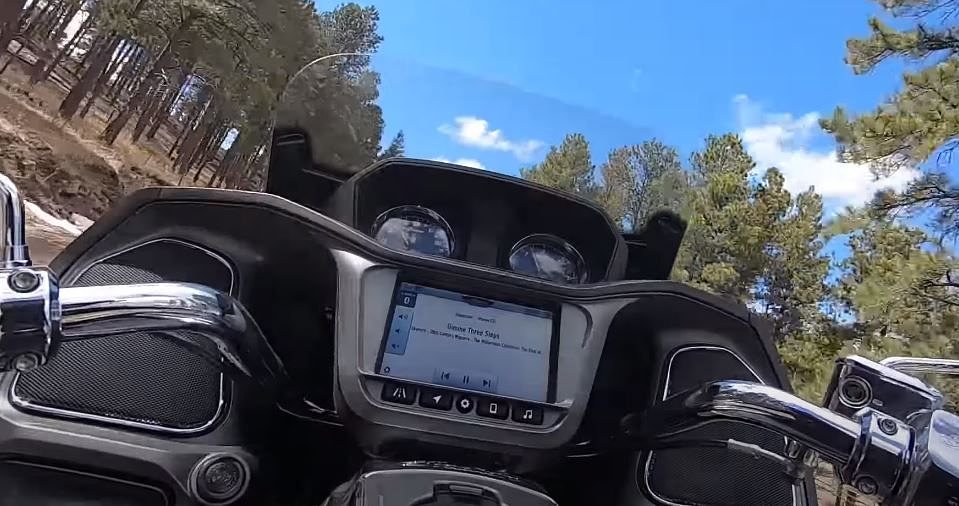
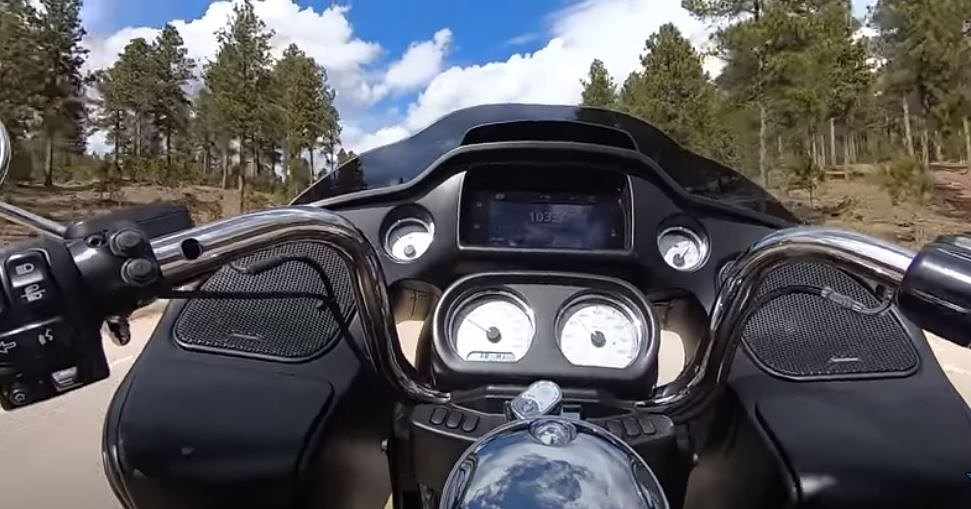
Both bikes have comparable infotainment systems with loads of features, GPS navigation and stereos. The Indian stereo is a 100-watt system while the H-D is only 25 watts per channel and it shows. The Indian is noticeably louder, but with that said they could both benefit from an aftermarket amp and speakers. The ride tracking is a bit better on the Indian and the display is just better looking. On top of that I found the Indian system more intuitive to use than the H-D. The cockpit area of the Road Glide left me reaching for the dash to use the touchscreen and vent. The Indian screen was easier to reach and I appreciated the gauges being above the screen and shaded. The electronically controlled windshield is a game changer on the Challenger. Again both bikes would benefit from a handlebar and seat swap if they were in your garage to personalize your riding position. The front lights are LED on both bikes while only the Indian carries rear LEDs. Storage up front was very similar with the glove boxes with USB port in the fairing. The saddlebags however are much different. The Indian locks and latches on the top of the bags are clunky compared to the H-D's side-mounted system, and removal of the Road Glide's bags are simple and require no tools while the Indian will require a wrench.
Is there a winner?
For me, yes there is a winner. If I was going to spend $23,000 of my hard-earned dollars on an American-made fixed fairing V-Twin it would without a doubt be the Indian Challenger. It's smooth, quick and in bagger terms a scalpel...OK, let's call it a machete in corners. The cockpit is very functional and intuitive and the electronics package that comes standard is significant. If there is a caveat, it's that the Road Glide will have more aftermarket selections currently. That being said, you will spend a fair amount to get the Road Glide to where the Challenger is already sitting. I know there is going to be some discussions around these bikes driven by brand loyalty and there's certainly a place for that. I'm glad that Indian pushed the production performance bagger envelope a bit with the Challenger, as motorcyclists we all stand to benefit from innovation. Your move, Harley-Davidson.



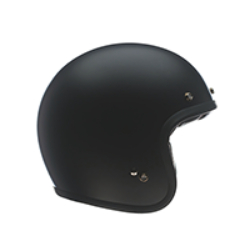

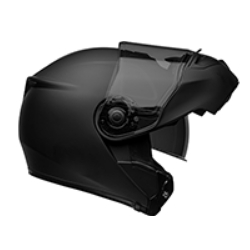

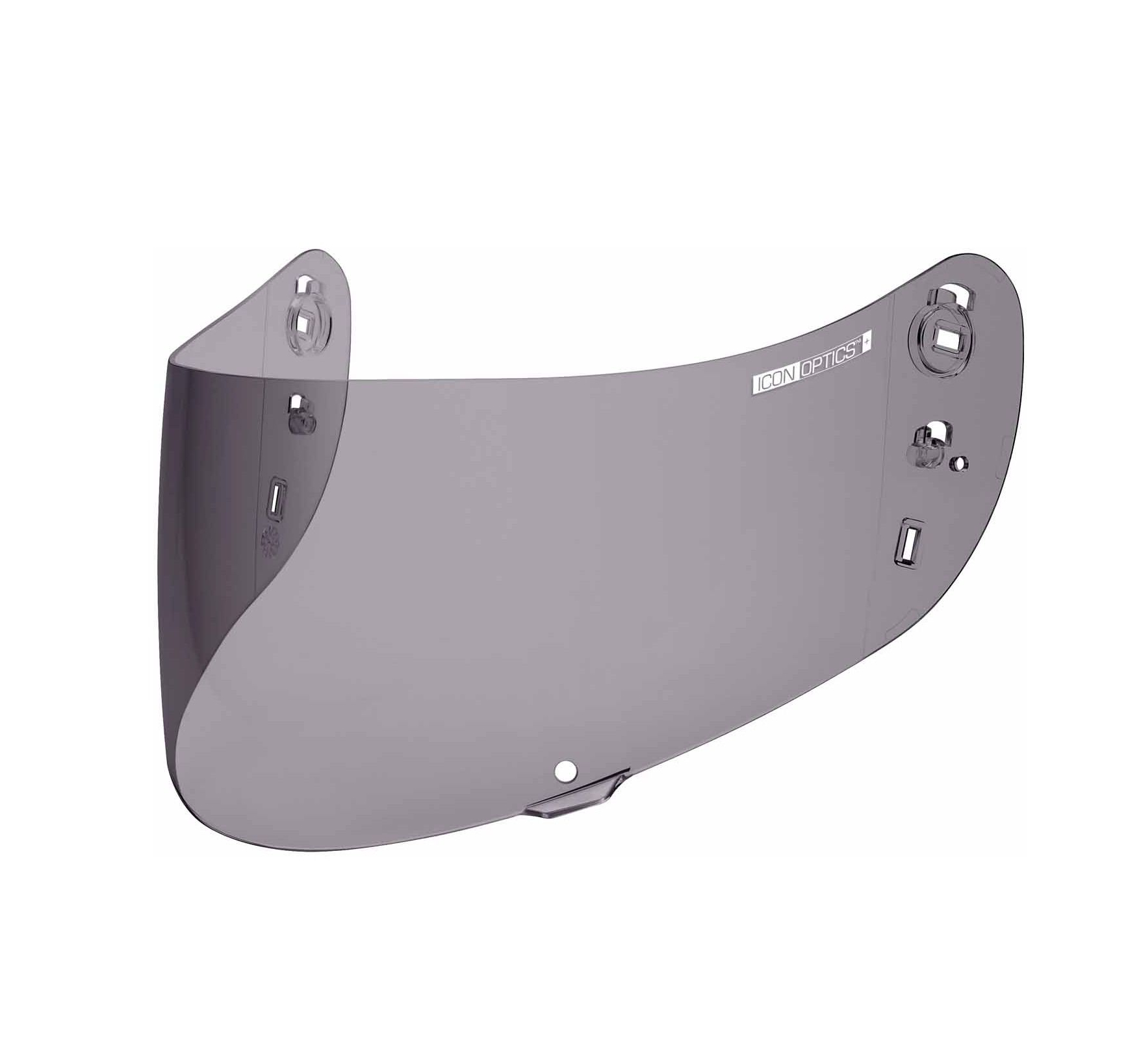
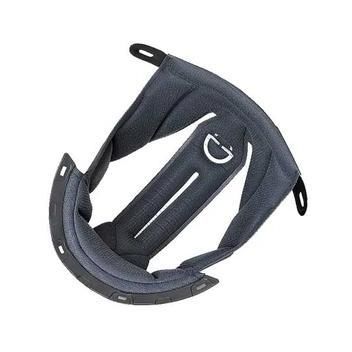
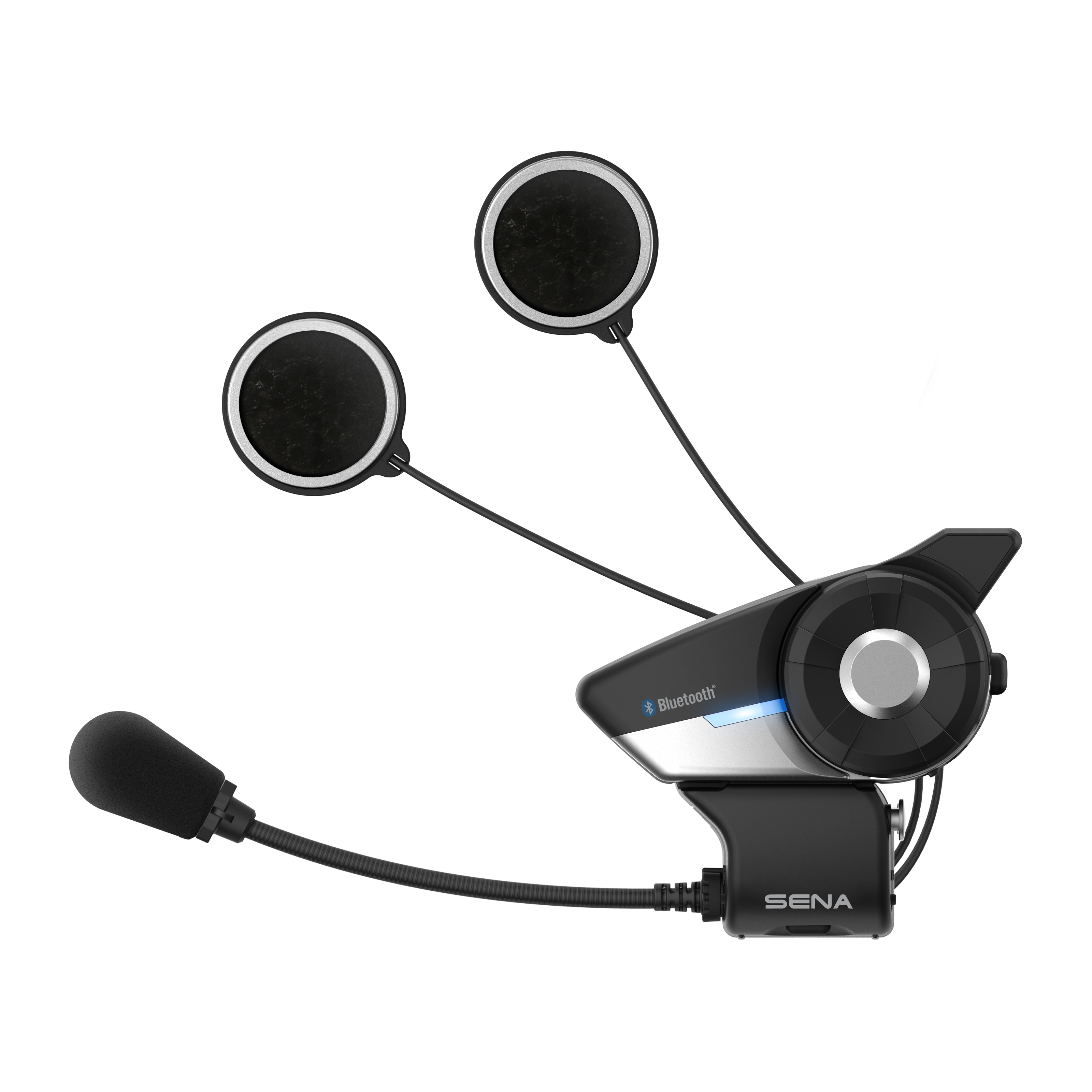


 Membership
Membership



